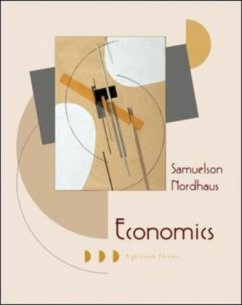Samuelson’s text was first published in 1948, and it immediately became the authority for the principles of economics courses. The book continues to be the standard-bearer for principles courses, and this revision continues to be a clear, accurate, and interesting introduction to modern economics principles. Bill Nordhaus is now the primary author of this text, and he has revised the book to be as current and relevant as ever.
Table of contents:
Part One: Basic Concepts 1 The Fundamentals of Economics Appendix 1 How to Read Graphs 2 Markets and Government in a Modern Economy 3 Basic Elements of Supply and Demand Part Two: Microeconomics: Supply, Demand, and Product Markets 4 Applications of Supply and Demand 5 Demand and Consumer Behavior Appendix 5 Geometrical Analysis of Consumer Equilibrium 6 Production and Business Organization 7 Analysis of Costs Appendix 7 Production, Cost Theory, and Decision of the Firm 8 Analysis of Perfectly Competitive Markets 9 Competition and Its Polar Case of Monopoly 10 Oligopoly and Monopolistic Competition 11 Uncertainty and Game Theory Part Three: Factor Markets: Labor, Land, and Capital 12 How Markets Determine Incomes 13 The Labor Market 14 Land and Capital Appendix 14 Markets and Economic Efficiency Part Four: Applied Microeconomics: International Trade, Government, and the Environment 15 Comparative Advantage and Protectionism 16 Government Taxation and Expenditure 17 Promoting More Efficient Markets 18 Protecting the Environment 19 Efficiency vs. Equality: The Big Tradeoff Part Five: Macroeconomics: Economic Growth and Business Cycles 20 Overview of Macroeconomics Appendix 20 Macroeconomic Data 21 Measuring Economic Activity 22 Consumption and Investment 23 Business Fluctuations and the Theory of Aggregate Demand 24 The Multiplier Model 25 Money, Banking, and Financial Markets 26 Central Banking and Monetary Policy Part Six: Economic Growth and Macroeconomic Policy 27 The Process of Economic Growth 28 The Challenge of Economic Development 29 Exchange Rates and the International Financial System 30 Open-Economy Macroeconomics Part Seven: Unemployment, Inflation, and Economic Policy 31 Unemployment and the Foundations of Aggregate Supply 32 Ensuring Price Stability 33 The Warring Schools of Macroeconomics 34 Policies for Growth and Stability
Table of contents:
Part One: Basic Concepts 1 The Fundamentals of Economics Appendix 1 How to Read Graphs 2 Markets and Government in a Modern Economy 3 Basic Elements of Supply and Demand Part Two: Microeconomics: Supply, Demand, and Product Markets 4 Applications of Supply and Demand 5 Demand and Consumer Behavior Appendix 5 Geometrical Analysis of Consumer Equilibrium 6 Production and Business Organization 7 Analysis of Costs Appendix 7 Production, Cost Theory, and Decision of the Firm 8 Analysis of Perfectly Competitive Markets 9 Competition and Its Polar Case of Monopoly 10 Oligopoly and Monopolistic Competition 11 Uncertainty and Game Theory Part Three: Factor Markets: Labor, Land, and Capital 12 How Markets Determine Incomes 13 The Labor Market 14 Land and Capital Appendix 14 Markets and Economic Efficiency Part Four: Applied Microeconomics: International Trade, Government, and the Environment 15 Comparative Advantage and Protectionism 16 Government Taxation and Expenditure 17 Promoting More Efficient Markets 18 Protecting the Environment 19 Efficiency vs. Equality: The Big Tradeoff Part Five: Macroeconomics: Economic Growth and Business Cycles 20 Overview of Macroeconomics Appendix 20 Macroeconomic Data 21 Measuring Economic Activity 22 Consumption and Investment 23 Business Fluctuations and the Theory of Aggregate Demand 24 The Multiplier Model 25 Money, Banking, and Financial Markets 26 Central Banking and Monetary Policy Part Six: Economic Growth and Macroeconomic Policy 27 The Process of Economic Growth 28 The Challenge of Economic Development 29 Exchange Rates and the International Financial System 30 Open-Economy Macroeconomics Part Seven: Unemployment, Inflation, and Economic Policy 31 Unemployment and the Foundations of Aggregate Supply 32 Ensuring Price Stability 33 The Warring Schools of Macroeconomics 34 Policies for Growth and Stability

